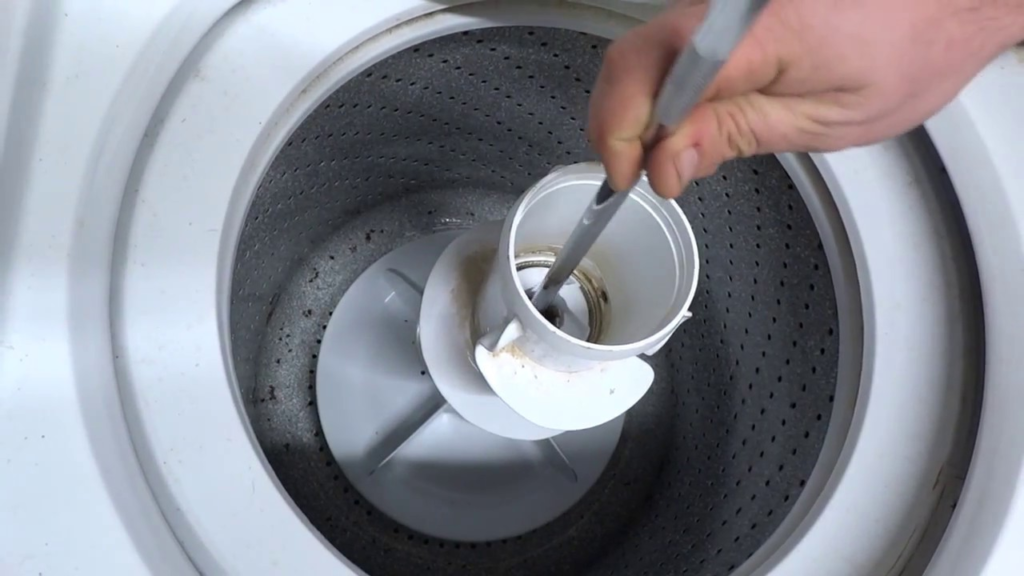A washing machine is a workhorse of the modern home, silently tackling mountains of dirty clothes. But what happens when that trusty appliance sputters to a halt, leaving your laundry swimming in a sea of suds? A common culprit: a washer that refuses to drain.
Fear not, fellow laundry warriors! This isn’t necessarily a washing machine write-off. Here’s a comprehensive guide to help you diagnose and potentially fix a washer stuck on spin cycle, along with some tips to prevent future aquatic mishaps.

The Drain Dance: Understanding How Your Washer Works
Before diving into troubleshooting, let’s understand the basic mechanics of the draining process. During the spin cycle, the washer’s motor rapidly rotates the drum, forcing water out through the drain hose. This water then exits through the drainpipe and into your home’s plumbing system.
Several components play a role in this watery ballet:
Drain Pump: This hidden hero is essentially a small electric pump that pushes the water out of the washer tub.
Drain Hose: This hose carries the expelled water from the pump to the drainpipe.
Drain Filter: This filter, often located near the pump, traps debris like coins, buttons, and lint, preventing them from clogging the pump or drainpipe.
Lid Switch (Top-Load Washers only): This switch ensures the lid is securely closed before the washer enters the spin cycle, including draining.
Why Won’t My Washer Drain? Top Culprits and Solutions
Now that we know the players, let’s identify the common reasons behind a washer on strike:
Clogged Drain Hose or Pump: This is the most frequent culprit. Coins, buttons, safety pins, or even a rogue sock can get lodged in the drain hose or pump, hindering water flow.
Solution:
Unplug the washer for safety before attempting any repairs.
Look for a small access panel or clamp that allows you to detach the hose.
Place a shallow pan or bucket underneath to catch any remaining water.
Carefully detach the hose and inspect it for clogs. You can use a long, thin object like a straightened wire hanger to remove any blockages.
Many washers also have a dedicated drain filter, which can be accessed from the front or back of the machine (consult your owner’s manual for specific instructions). Clean the filter thoroughly, removing any debris you find.
Once everything is clear, reattach the hose securely.
Kinked Drain Hose: A bent or kinked drain hose can restrict water flow.
Solution:
Check the drain hose for any kinks or twists that might be impeding the water flow. Straighten the hose as needed.
Faulty Drain Pump: If the clog isn’t the issue, the drain pump itself might be malfunctioning.
Solution:
Diagnosing a faulty pump can be a bit trickier. Some washing machines have a built-in diagnostic mode that can help identify pump issues. Consult your owner’s manual for specific instructions.
Replacing a drain pump usually requires some disassembly and might be best left to a qualified appliance repair person.
Lid Switch Malfunction (Top-Load Washers Only): A faulty lid switch can prevent the washer from entering the spin cycle, including draining.
Solution:
A faulty lid switch is less common, but it can happen. Consult your owner’s manual for instructions on testing and potentially replacing the lid switch. If you’re not comfortable with electrical repairs, consider calling a professional.
Leveling Issues: An unevenly leveled washer can cause drainage problems.
Solution:
Use a level to check if your washer is sitting flat. If not, adjust the leveling legs at the bottom of the machine until it’s level.
Water Level Control Issues: A malfunctioning water level control switch can trick the washer into thinking it’s still full of water, preventing the spin cycle from starting.
Solution:
Diagnosing and fixing a water level control issue is usually a job for a qualified appliance repair person.
Beyond the Basics: Additional Tips and Tricks
Consult Your Owner’s Manual: Your washer’s manual is a goldmine of information. It will provide specific instructions on troubleshooting common problems, including how to access the drain hose, pump, and filter for your particular model.

FAQ’S
Why Won’t My Washer Drain?
There are several reasons why your washer might be stuck on a full belly of water. Here are the most common culprits:
Clogged Drain Hose: This is the number one suspect. Coins, buttons, socks, and other debris can get lodged in the hose, blocking the water flow.
Clogged Drain Pump Filter: Especially in front-load washers, a filter traps lint, hair, and other small items that can prevent the pump from functioning correctly.
Kinked Drain Hose: If the hose is bent or twisted, it can restrict water flow.
Faulty Drain Pump: The pump itself might be malfunctioning and unable to push the water out.
Lid Switch Malfunction (Top-Load Washers Only): A broken lid switch can prevent the washer from spinning or draining, as it thinks the lid is open for safety reasons.
Leveling Issues: An uneven washer can cause drainage problems.
Troubleshooting Steps:
Before diving into any repairs, make sure the washer is unplugged for safety reasons.
Manual Drain: Most washers have a built-in drain hose or filter access point that allows you to manually remove excess water. Consult your washer’s manual for specific instructions. This will help you determine if the clog is in the hose or deeper in the system.
Check the Drain Hose: Look for kinks or blockages in the hose. You might be able to remove debris by hand or with a long, thin object. Some hoses have access points at the end to remove clogs.
Clean the Drain Pump Filter: Locate the filter (usually behind a small panel at the front bottom of the washer for front-loaders). Empty the trapped water into a container and clean the filter with warm water.
Level the Washer: Uneven legs can cause drainage problems. Use a level and adjustable wrench to adjust the washer’s legs until it sits level.
If the Simple Fixes Don’t Work:
If you’ve tried the steps above and your washer is still not draining, it might be time for a deeper investigation. Here’s what to do next:
Check the Lid Switch (Top-Load Washers Only): Consult your washer’s manual for instructions on testing the lid switch with a multimeter. If it’s faulty, you may need to replace it.
Consult Your Washer’s Manual: Your washer’s manual will have specific troubleshooting steps and part replacement instructions for your model.
Call a Repair Person: If you’re not comfortable troubleshooting further, or if the issue seems more complex, it’s best to call a qualified appliance repair person.
Bonus Tips:
Preventative Maintenance: Regularly clean the drain pump filter to prevent future clogs.
Avoid Overloading: Don’t cram too many clothes into the washer. This can put extra strain on the pump and lead to drainage issues.
Use the Right Detergent: Using high-efficiency (HE) detergent in a non-HE washer can create excessive suds that can clog the drain.
To read more, Click here





